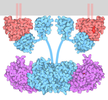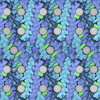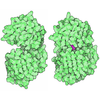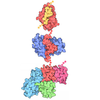[English] 日本語
 Yorodumi
Yorodumi- EMDB-48103: Lgl2 bound to the aPKCiota-Par6b complex in nucleotide-free form.... -
+ Open data
Open data
- Basic information
Basic information
| Entry |  | |||||||||
|---|---|---|---|---|---|---|---|---|---|---|
| Title | Lgl2 bound to the aPKCiota-Par6b complex in nucleotide-free form. Head sub-complex region subtracted | |||||||||
 Map data Map data | ||||||||||
 Sample Sample |
| |||||||||
 Keywords Keywords | Cell Polarity / Kinase / Complex / LIPID BINDING PROTEIN | |||||||||
| Function / homology |  Function and homology information Function and homology informationestablishment of spindle orientation / establishment or maintenance of polarity of embryonic epithelium / diacylglycerol-dependent, calcium-independent serine/threonine kinase activity / Golgi vesicle budding / PAR polarity complex / Tight junction interactions / regulation of establishment or maintenance of cell polarity / protein kinase C / establishment of apical/basal cell polarity / diacylglycerol-dependent serine/threonine kinase activity ...establishment of spindle orientation / establishment or maintenance of polarity of embryonic epithelium / diacylglycerol-dependent, calcium-independent serine/threonine kinase activity / Golgi vesicle budding / PAR polarity complex / Tight junction interactions / regulation of establishment or maintenance of cell polarity / protein kinase C / establishment of apical/basal cell polarity / diacylglycerol-dependent serine/threonine kinase activity / L-leucine transport / myosin II binding / regulation of Notch signaling pathway / negative regulation of glial cell apoptotic process / eye photoreceptor cell development / branching involved in labyrinthine layer morphogenesis / Schmidt-Lanterman incisure / establishment or maintenance of epithelial cell apical/basal polarity / Golgi to plasma membrane transport / membrane organization / cellular response to chemical stress / cell-cell junction organization / cortical actin cytoskeleton organization / protein targeting to membrane / tight junction / labyrinthine layer blood vessel development / cortical actin cytoskeleton / positive regulation of Notch signaling pathway / establishment of cell polarity / cell leading edge / exocytosis / brush border / positive regulation of endothelial cell apoptotic process / positive regulation of glial cell proliferation / bicellular tight junction / regulation of postsynaptic membrane neurotransmitter receptor levels / intercellular bridge / vesicle-mediated transport / cytoskeleton organization / secretion / p75NTR recruits signalling complexes / GTPase activator activity / response to interleukin-1 / actin filament organization / post-embryonic development / positive regulation of D-glucose import / protein localization to plasma membrane / positive regulation of protein localization to plasma membrane / adherens junction / PDZ domain binding / positive regulation of NF-kappaB transcription factor activity / positive regulation of neuron projection development / phospholipid binding / Pre-NOTCH Transcription and Translation / Schaffer collateral - CA1 synapse / multicellular organism growth / cellular response to insulin stimulus / KEAP1-NFE2L2 pathway / cell migration / microtubule cytoskeleton / negative regulation of neuron apoptotic process / protein phosphorylation / protein kinase activity / endosome / intracellular signal transduction / cilium / apical plasma membrane / Golgi membrane / cell division / protein serine kinase activity / intracellular membrane-bounded organelle / protein serine/threonine kinase activity / negative regulation of apoptotic process / glutamatergic synapse / extracellular exosome / zinc ion binding / nucleoplasm / ATP binding / nucleus / plasma membrane / cytoplasm / cytosol Similarity search - Function | |||||||||
| Biological species |   Homo sapiens (human) Homo sapiens (human) | |||||||||
| Method | single particle reconstruction / cryo EM / Resolution: 3.08 Å | |||||||||
 Authors Authors | Almagor L / Weis WI | |||||||||
| Funding support | 1 items
| |||||||||
 Citation Citation |  Journal: Commun Biol / Year: 2025 Journal: Commun Biol / Year: 2025Title: Polarity protein Par6 facilitates the processive phosphorylation of Lgl via a dynamic interaction with aPKC. Authors: Lior Almagor / William I Weis /  Abstract: Polarity along an apical-basal axis is essential for epithelial cell shape and function. The atypical protein Kinase-C (aPKC) and its regulatory partner Par6 form a complex that is essential for ...Polarity along an apical-basal axis is essential for epithelial cell shape and function. The atypical protein Kinase-C (aPKC) and its regulatory partner Par6 form a complex that is essential for polarization, a primary function of which is to phosphorylate the Lethal giant larvae (Lgl) protein to prevent it from binding to the apical membrane (thereby facilitating its basolateral localization). Par6 binds Lgl directly and is essential for this process, but its mechanism was obscure. Here, we utilize cryo-EM and various biochemical techniques to characterize the interaction of Lgl2 with the aPKCι/Par6 complex and to study the roles of Par6 in promoting Lgl2 phosphorylation. We find that Par6 proteins stabilize a ternary Lgl2/aPKCι/Par6 complex that involves a unique multi-surface interaction of Lgl2 with both aPKCι and Par6. Importantly, we find Par6b induces processive phosphorylation that results in a multi-phosphorylated Lgl2 after a single interaction with the aPKCι/Par6b complex. This is enabled by a Par6b/Lgl2 interaction that maintains contact of Lgl2 with the kinase throughout its distinct nucleotide-binding states. Our results reveal the mechanistic basis for the efficient regulation of Lgl's membrane binding by aPKC/Par6 and provide invaluable structural data for further understanding the mechanisms of this polarity complex. | |||||||||
| History |
|
- Structure visualization
Structure visualization
| Supplemental images |
|---|
- Downloads & links
Downloads & links
-EMDB archive
| Map data |  emd_48103.map.gz emd_48103.map.gz | 482.2 MB |  EMDB map data format EMDB map data format | |
|---|---|---|---|---|
| Header (meta data) |  emd-48103-v30.xml emd-48103-v30.xml emd-48103.xml emd-48103.xml | 20.8 KB 20.8 KB | Display Display |  EMDB header EMDB header |
| FSC (resolution estimation) |  emd_48103_fsc.xml emd_48103_fsc.xml | 17 KB | Display |  FSC data file FSC data file |
| Images |  emd_48103.png emd_48103.png | 105 KB | ||
| Filedesc metadata |  emd-48103.cif.gz emd-48103.cif.gz | 7.2 KB | ||
| Others |  emd_48103_half_map_1.map.gz emd_48103_half_map_1.map.gz emd_48103_half_map_2.map.gz emd_48103_half_map_2.map.gz | 475.1 MB 475.1 MB | ||
| Archive directory |  http://ftp.pdbj.org/pub/emdb/structures/EMD-48103 http://ftp.pdbj.org/pub/emdb/structures/EMD-48103 ftp://ftp.pdbj.org/pub/emdb/structures/EMD-48103 ftp://ftp.pdbj.org/pub/emdb/structures/EMD-48103 | HTTPS FTP |
-Validation report
| Summary document |  emd_48103_validation.pdf.gz emd_48103_validation.pdf.gz | 888.3 KB | Display |  EMDB validaton report EMDB validaton report |
|---|---|---|---|---|
| Full document |  emd_48103_full_validation.pdf.gz emd_48103_full_validation.pdf.gz | 887.9 KB | Display | |
| Data in XML |  emd_48103_validation.xml.gz emd_48103_validation.xml.gz | 26.4 KB | Display | |
| Data in CIF |  emd_48103_validation.cif.gz emd_48103_validation.cif.gz | 34.5 KB | Display | |
| Arichive directory |  https://ftp.pdbj.org/pub/emdb/validation_reports/EMD-48103 https://ftp.pdbj.org/pub/emdb/validation_reports/EMD-48103 ftp://ftp.pdbj.org/pub/emdb/validation_reports/EMD-48103 ftp://ftp.pdbj.org/pub/emdb/validation_reports/EMD-48103 | HTTPS FTP |
-Related structure data
| Related structure data |  9ejkMC  9ejlC  9ejmC M: atomic model generated by this map C: citing same article ( |
|---|---|
| Similar structure data | Similarity search - Function & homology  F&H Search F&H Search |
- Links
Links
| EMDB pages |  EMDB (EBI/PDBe) / EMDB (EBI/PDBe) /  EMDataResource EMDataResource |
|---|---|
| Related items in Molecule of the Month |
- Map
Map
| File |  Download / File: emd_48103.map.gz / Format: CCP4 / Size: 512 MB / Type: IMAGE STORED AS FLOATING POINT NUMBER (4 BYTES) Download / File: emd_48103.map.gz / Format: CCP4 / Size: 512 MB / Type: IMAGE STORED AS FLOATING POINT NUMBER (4 BYTES) | ||||||||||||||||||||||||||||||||||||
|---|---|---|---|---|---|---|---|---|---|---|---|---|---|---|---|---|---|---|---|---|---|---|---|---|---|---|---|---|---|---|---|---|---|---|---|---|---|
| Projections & slices | Image control
Images are generated by Spider. | ||||||||||||||||||||||||||||||||||||
| Voxel size | X=Y=Z: 0.5555 Å | ||||||||||||||||||||||||||||||||||||
| Density |
| ||||||||||||||||||||||||||||||||||||
| Symmetry | Space group: 1 | ||||||||||||||||||||||||||||||||||||
| Details | EMDB XML:
|
-Supplemental data
-Half map: #1
| File | emd_48103_half_map_1.map | ||||||||||||
|---|---|---|---|---|---|---|---|---|---|---|---|---|---|
| Projections & Slices |
| ||||||||||||
| Density Histograms |
-Half map: #2
| File | emd_48103_half_map_2.map | ||||||||||||
|---|---|---|---|---|---|---|---|---|---|---|---|---|---|
| Projections & Slices |
| ||||||||||||
| Density Histograms |
- Sample components
Sample components
-Entire : A ternary complex of Lgl2 with aPKC iota and Par6B (nucleotide-free).
| Entire | Name: A ternary complex of Lgl2 with aPKC iota and Par6B (nucleotide-free). |
|---|---|
| Components |
|
-Supramolecule #1: A ternary complex of Lgl2 with aPKC iota and Par6B (nucleotide-free).
| Supramolecule | Name: A ternary complex of Lgl2 with aPKC iota and Par6B (nucleotide-free). type: complex / ID: 1 / Parent: 0 / Macromolecule list: all |
|---|
-Supramolecule #2: A ternary complex of Lgl2 with aPKC iota and Par6B (nucleotide-free).
| Supramolecule | Name: A ternary complex of Lgl2 with aPKC iota and Par6B (nucleotide-free). type: complex / ID: 2 / Parent: 1 / Macromolecule list: #3 |
|---|---|
| Source (natural) | Organism:  |
-Supramolecule #3: A ternary complex of Lgl2 with aPKC iota and Par6B (nucleotide-free).
| Supramolecule | Name: A ternary complex of Lgl2 with aPKC iota and Par6B (nucleotide-free). type: complex / ID: 3 / Parent: 1 / Macromolecule list: #1-#2 |
|---|---|
| Source (natural) | Organism:  Homo sapiens (human) Homo sapiens (human) |
-Macromolecule #1: LLGL scribble cell polarity complex component 2
| Macromolecule | Name: LLGL scribble cell polarity complex component 2 / type: protein_or_peptide / ID: 1 / Number of copies: 1 / Enantiomer: LEVO |
|---|---|
| Source (natural) | Organism:  Homo sapiens (human) Homo sapiens (human) |
| Molecular weight | Theoretical: 109.362188 KDa |
| Recombinant expression | Organism:  |
| Sequence | String: MRERLKRDLF QFNKTVEHGF PHQPSALGYS PSLRILAIGT RSGAIKLYGA PGVEFMGLHQ ENNAVTQIHL LPGQCQLVTL LDDNSLHLW SLKVKGGASE LQEDESFTLR GPPGAAPSAT QITVVLPHSS CELLYLGTES GNVFVVQLPA FRALEDRTIS S DAVLQRLP ...String: MRERLKRDLF QFNKTVEHGF PHQPSALGYS PSLRILAIGT RSGAIKLYGA PGVEFMGLHQ ENNAVTQIHL LPGQCQLVTL LDDNSLHLW SLKVKGGASE LQEDESFTLR GPPGAAPSAT QITVVLPHSS CELLYLGTES GNVFVVQLPA FRALEDRTIS S DAVLQRLP EEARHRRVFE MVEALQEHPR DPNQILIGYS RGLVVIWDLQ GSRVLYHFLS SQQLENIWWQ RDGRLLVSCH SD GSYCQWP VSSEAQQPEP LRSLVPYGPF PCKAITRILW LTTRQGLPFT IFQGGMPRAS YGDRHCISVI HDGQQTAFDF TSR VIGFTV LTEADPAATF DDPYALVVLA EEELVVIDLQ TAGWPPVQLP YLASLHCSAI TCSHHVSNIP LKLWERIIAA GSRQ NAHFS TMEWPIDGGT SLTPAPPQRD LLLTGHEDGT VRFWDASGVC LRLLYKLSTV RVFLTDTDPN ENFSAQGEDE WPPLR KVGS FDPYSDDPRL GIQKIFLCKY SGYLAVAGTA GQVLVLELND EAAEQAVEQV EADLLQDQEG YRWKGHERLA ARSGPV RFE PGFQPFVLVQ CQPPAVVTSL ALHSEWRLVA FGTSHGFGLF DHQQRRQVFV KCTLHPSDQL ALEGPLSRVK SLKKSLR QS FRRMRRSRVS SRKRHPAGPP GEAQEGSAKA ERPGLQNMEL APVQRKIEAR SAEDSFTGFV RTLYFADTYL KDSSRHCP S LWAGTNGGTI YAFSLRVPPA ERRMDEPVRA EQAKEIQLMH RAPVVGILVL DGHSVPLPEP LEVAHDLSKS PDMQGSHQL LVVSEEQFKV FTLPKVSAKL KLKLTALEGS RVRRVSVAHF GSRRAEDYGE HHLAVLTNLG DIQVVSLPLL KPQVRYSCIR REDVSGIAS CVFTKYGQGF YLISPSEFER FSLSTKWLVE PRCLVDSAET KNHRPGNGAG PKKAPSRARN SGTQSDGEEK Q PGLVMERE FTTSASENLY FQ UniProtKB: LLGL scribble cell polarity complex component 2 |
-Macromolecule #2: Protein kinase C iota type
| Macromolecule | Name: Protein kinase C iota type / type: protein_or_peptide / ID: 2 / Number of copies: 1 / Enantiomer: LEVO / EC number: protein kinase C |
|---|---|
| Source (natural) | Organism:  Homo sapiens (human) Homo sapiens (human) |
| Molecular weight | Theoretical: 68.512258 KDa |
| Recombinant expression | Organism:  |
| Sequence | String: MPTQRDSSTM SHTVAGGGSG DHSHQVRVKA YYRGDIMITH FEPSISFEGL CNEVRDMCSF DNEQLFTMKW IDEEGDPCTV SSQLELEEA FRLYELNKDS ELLIHVFPCV PERPGMPCPG EDKSIYRRGA RRWRKLYCAN GHTFQAKRFN RRAHCAICTD R IWGLGRQG ...String: MPTQRDSSTM SHTVAGGGSG DHSHQVRVKA YYRGDIMITH FEPSISFEGL CNEVRDMCSF DNEQLFTMKW IDEEGDPCTV SSQLELEEA FRLYELNKDS ELLIHVFPCV PERPGMPCPG EDKSIYRRGA RRWRKLYCAN GHTFQAKRFN RRAHCAICTD R IWGLGRQG YKCINCKLLV HKKCHKLVTI ECGRHSLPQE PVMPMDQSSM HSDHAQTVIP YNPSSHESLD QVGEEKEAMN TR ESGKASS SLGLQDFDLL RVIGRGSYAK VLLVRLKKTD RIYAMKVVKK ELVNDDEDID WVQTEKHVFE QASNHPFLVG LHS CFQTES RLFFVIEYVN GGDLMFHMQR QRKLPEEHAR FYSAEISLAL NYLHERGIIY RDLKLDNVLL DSEGHIKLTD YGMC KEGLR PGDTTS(TPO)FCG TPNYIAPEIL RGEDYGFSVD WWALGVLMFE MMAGRSPFDI VGSSDNPDQN TEDYLFQVIL E KQIRIPRS LSVKAASVLK SFLNKDPKER LGCHPQTGFA DIQGHPFFRN VDWDMMEQKQ VVPPFKPNIS GEFGLDNFDS QF TNEPVQL (TPO)PDDDDIVRK IDQSEFEGFE YINPLLMSAE ECV UniProtKB: Protein kinase C iota type |
-Macromolecule #3: Partitioning defective 6 homolog beta
| Macromolecule | Name: Partitioning defective 6 homolog beta / type: protein_or_peptide / ID: 3 / Number of copies: 1 / Enantiomer: LEVO |
|---|---|
| Source (natural) | Organism:  |
| Molecular weight | Theoretical: 42.472445 KDa |
| Recombinant expression | Organism:  |
| Sequence | String: MNRGHRHGAS SGCLGTMEVK SKFGAEFRRF SLERSKPGKF EEFYGLLQHV HKIPNVDVLV GYADIHGDLP PINNDDNYHK AVSTANPLL RIFIQKKEEA DYSAFGTDTL IRKKNMLSNV LRPDNHRKKP HIVISMPQDF RPVSSIIDVD ILPETHRRVR L CKYGTEKP ...String: MNRGHRHGAS SGCLGTMEVK SKFGAEFRRF SLERSKPGKF EEFYGLLQHV HKIPNVDVLV GYADIHGDLP PINNDDNYHK AVSTANPLL RIFIQKKEEA DYSAFGTDTL IRKKNMLSNV LRPDNHRKKP HIVISMPQDF RPVSSIIDVD ILPETHRRVR L CKYGTEKP LGFYIRDGSS VRVTPHGLEK VPGIFISRLV PGGLAQSTGL LAVNDEVLEV NGIEVSGKSL DQVTDMMIAN SR NLIITVR PANQRNNVVR NSRTSGSSSQ STDNSLLGFP QQVEASFEPE DQDSDEDDII IEDSGEPQQI PKATPAQSLE SLT QIELSF ESGQNGFSPP QDTSLVPVPG SLDTELESRA PDQKLLEEDG TIITLEFTTA SENLYFQ |
-Experimental details
-Structure determination
| Method | cryo EM |
|---|---|
 Processing Processing | single particle reconstruction |
| Aggregation state | particle |
- Sample preparation
Sample preparation
| Concentration | 0.2 mg/mL |
|---|---|
| Buffer | pH: 8 |
| Grid | Model: Quantifoil R1.2/1.3 / Material: GOLD / Support film - Material: GOLD / Support film - topology: HOLEY ARRAY / Pretreatment - Type: GLOW DISCHARGE |
| Vitrification | Cryogen name: ETHANE / Chamber humidity: 100 % / Chamber temperature: 295 K / Instrument: FEI VITROBOT MARK IV |
| Details | 20 mM Tris 200 mM NaCl 1 mM DTT 0.05% n-octyl-beta-D-glucoside |
- Electron microscopy
Electron microscopy
| Microscope | TFS KRIOS |
|---|---|
| Details | Data collected at both 25 and 40 degrees tilt |
| Image recording | Film or detector model: GATAN K3 (6k x 4k) / Average electron dose: 65.0 e/Å2 |
| Electron beam | Acceleration voltage: 300 kV / Electron source:  FIELD EMISSION GUN FIELD EMISSION GUN |
| Electron optics | C2 aperture diameter: 100.0 µm / Calibrated defocus max: 4.0 µm / Calibrated defocus min: 1.0 µm / Illumination mode: FLOOD BEAM / Imaging mode: BRIGHT FIELD / Cs: 2.7 mm / Nominal defocus max: 4.0 µm / Nominal defocus min: 1.0 µm / Nominal magnification: 81000 |
| Experimental equipment |  Model: Titan Krios / Image courtesy: FEI Company |
 Movie
Movie Controller
Controller

















 Z (Sec.)
Z (Sec.) Y (Row.)
Y (Row.) X (Col.)
X (Col.)





































